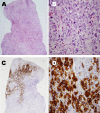Mycosis fungoides and CD30+ cutaneous T-cell lymphoma simulating pyoderma gangrenosum in a patient with ulcerative colitis
- PMID: 21886726
- PMCID: PMC3157792
- DOI: 10.3315/jdcr.2009.1030
Mycosis fungoides and CD30+ cutaneous T-cell lymphoma simulating pyoderma gangrenosum in a patient with ulcerative colitis
Abstract
Background: Pyoderma gangrenosum is estimated to occur in 5% to 12% of ulcerative colitis patients. Primary CD30+ cutaneous large cell lymphoma is the second most common cutaneous lymphoma. It may coexists with mycosis fungoides.
Main observations: We report a 38-years-old female patient with 12 year history of ulcerative colitis, treated previously with 5-aminosalicylic acid and systemic corticosteroids. The disease has been in remission for the past 1.5 years, with no maintenance treatment. The patient then developed a rapidly progressing ulcerated lesion clinically simulating pyoderma gangrenosum. Physical examination revealed also a small number of hairless hypopigmented patches on the upper and lower limbs which she claimed to have appeared 4 years ago. Surprisingly a histological evaluation of the ulcer revealed a CD30+ primary cutaneous large cell lymphoma, while histology of hypopigmented lesions revealed mycosis fungoides, patch stage. T-cell receptor gene rearrangement from the two lesions didn't reveal the same T Cell clonalitiy and the patients lymphoma was stable.
Conclusion: Our case presents the rare coexistence of primary mycosis fungoides and primary CD30+ cutaneous large cell lymphoma, rather than the CD30+ cutaneous large cell lymphoma developing from mycosis fungoides. This case also presents the development of a pyoderma gangrenosum-like lesion of CD30+ cutaneous large cell lymphoma in a patient with ulcerative colitis. An observation that emphasizes the need for a high index of suspicion in cases diagnosed as pyoderma gangrenosum based solely on clinical appearance.
Keywords: cutaneous T-cell lymphoma; inflammatory bowel disease; mycosis fungoides; pyoderma gangrenosum; ulcer; ulcerative colitis.
Figures
Similar articles
-
Generalized Pyoderma Gangrenosum Associated with Ulcerative Colitis: Successful Treatment with Infliximab and Azathioprine.Acta Dermatovenerol Croat. 2016 Apr;24(1):83-5. Acta Dermatovenerol Croat. 2016. PMID: 27149138
-
Mycosis fungoides presenting with extensive pyoderma gangrenosum-like ulcers.J Eur Acad Dermatol Venereol. 2002 Jul;16(4):401-4. doi: 10.1046/j.1468-3083.2002.00468.x. J Eur Acad Dermatol Venereol. 2002. PMID: 12224703
-
Pyoderma gangrenosum-like CD30+ cutaneous T-cell lymphoma in a patient with mycosis fungoides.J Eur Acad Dermatol Venereol. 2015 Apr;29(4):819-21. doi: 10.1111/jdv.12418. Epub 2014 Feb 27. J Eur Acad Dermatol Venereol. 2015. PMID: 24576263 No abstract available.
-
[Ulcerative colitis associated with pyoderma gangrenosum].Orv Hetil. 1994 Apr 24;135(17):917-9. Orv Hetil. 1994. PMID: 7909938 Review. Hungarian.
-
Pyoderma gangrenosum on the nose.Auris Nasus Larynx. 2018 Oct;45(5):1130-1134. doi: 10.1016/j.anl.2018.04.004. Epub 2018 May 10. Auris Nasus Larynx. 2018. PMID: 29753583 Review.
Cited by
-
Concomitant B Hairy Cell Leukemia and Mycosis Fungoides in an Elderly Man.Case Rep Dermatol. 2017 Apr 7;9(1):103-107. doi: 10.1159/000456650. eCollection 2017 Jan-Apr. Case Rep Dermatol. 2017. PMID: 28512405 Free PMC article.
-
Pyoderma gangrenosum in a patient with cutaneous T-cell lymphoma.JAAD Case Rep. 2015 Mar 27;1(2):93-5. doi: 10.1016/j.jdcr.2015.01.010. eCollection 2015 Mar. JAAD Case Rep. 2015. PMID: 27051695 Free PMC article. No abstract available.
-
Mycosis Fungoides: Uncommon Presentation.Int J Appl Basic Med Res. 2021 Jan-Mar;11(1):53-55. doi: 10.4103/ijabmr.IJABMR_348_20. Epub 2021 Jan 26. Int J Appl Basic Med Res. 2021. PMID: 33842299 Free PMC article.
-
CD8-positive Mycosis Fungoides Masquerading as Pyoderma Gangrenosum.Indian J Dermatol. 2016 Sep-Oct;61(5):580. doi: 10.4103/0019-5154.190126. Indian J Dermatol. 2016. PMID: 27688458 Free PMC article.
References
-
- Bekkenk MW, Geelen FA, van Voorst Vader PC, Heule F, Geerts ML, van Vloten WA, Meijer CJ, Willemze R. Primary and secondary cutaneous CD30(+) lymphoproliferative disorders: a report from the Dutch Cutaneous Lymphoma Group on the long-term follow-up data of 219 patients and guidelines for diagnosis and treatment. Blood. 2000;95:3653–3661. - PubMed
-
- Ralfkiaer E, Delsol G, Willemze R, Jaffe E. Primary cutaneous CD30-positive T-cell lymphoproliferative disorders. World Health Organization classification of tumors. Pathology and genetics of tumors of hematopoetic and lymphoid tissues. Lyon (France): IARC Press; 2001. pp. 221–224.
-
- Kadin ME. Pathobiology of CD30+ cutaneous T-cell lymphomas. J Cutan Pathol. 2006;33:10–17. - PubMed
-
- Kang SK, Chang SE, Choi JH, Sung KJ, Moon KC, Koh JK. Coexistence of CD30-positive anaplastic large cell lymphoma and mycosis fungoides. Clin Exp Dermatol. 2002;27:212–215. - PubMed
-
- LeBoit PE. Lymphomatoid papulosis and cutaneous CD30+ lymphoma. Am J Dermatopathol. 1996;18:221–235. - PubMed
Publication types
LinkOut - more resources
Full Text Sources
Miscellaneous

